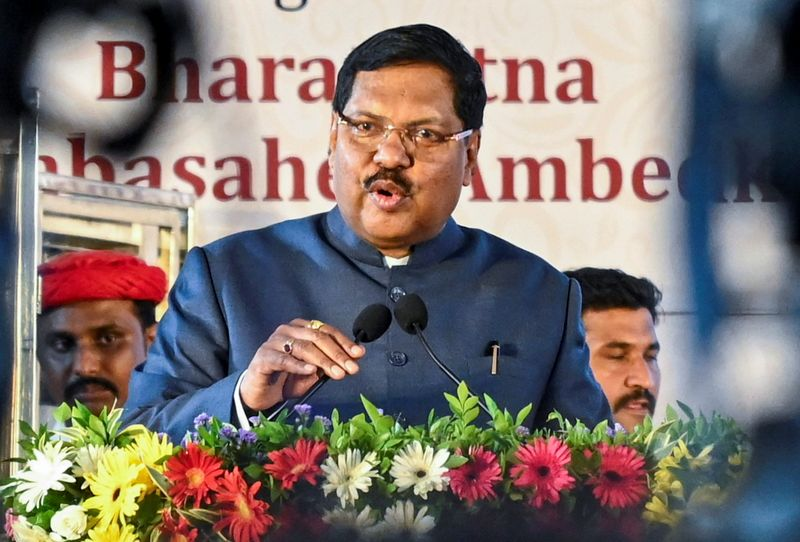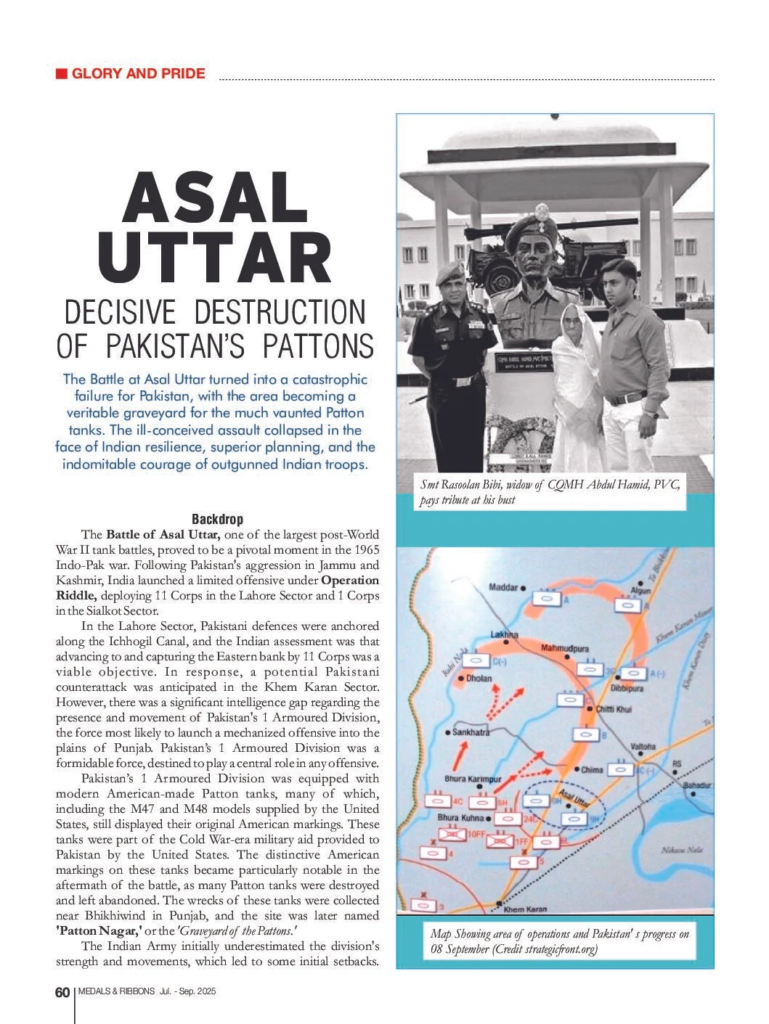All posts by webadmin
ADAL UTTAR :DESTRUCTION OF PAK TANKS
THE SECRETS OF SHUBHANSHU SHUKLA

Medals and Ribbons has focused on the 1965 Indo Pak War – Diamond Jubilee of that war.

The July 25 issue of Medals and Ribbons has focused on the 1965 Indo Pak War – Diamond Jubilee of that war.
The magazine articles highlight the devious designs of Pakistan to wrest Kashmir, their perspective of the war, and the impact of the war on India Pakistan relations thereafter.
The historic victory at Haji Pir, the Battles of Chhamb, Phillora, Chawinda, Dograi, Khem Karan Asal Uttar) and OP Hill have been described. My article on Asal Uttar (Grave Yard of the Patton Tank) talks about one of the greatest tank battles fought by the Indian Army and a knockout blow to the Pak 1 Armd Div.
The issue also delves into the strategic fallout of Operation Sindoor, and looks at the Offensive air operation and the Air Defence success.
An interesting comparison between life in 1965 and today throws light on lifestyle changes and choices.

http://www.medalsandribbons.com
program for the Indian Military’s seminar on Indigenisation of drones by HQ IDS on 16 July 2025 at Manekshaw Centre, Delhi.
This is the confirmed program for the Indian Military’s seminar on Indigenisation of drones by HQ IDS on 16 July 2025 at Manekshaw Centre, Delhi. The detailed program schedule is attached
It’s absolutely free of cost to ensure maximum participation by Indian Drones & C-UAS companies & start-ups interested in complete Indigenisation. If you have 100% indegenised any component also or planning to do so, come & display it. If you are completely confident of your product’s Indigenisation, you can speak about it also
Please confirm your interest at the earliest
- Display stall
- Only attendance as delegate
- Speaking slot
- Give details of your Indigenisation component, complete product, software etc whether drones or C-UAS. Brouchure is preferable
the idea is 100% Indigenisation eventually
Warmest regards
Brigadier Anshuman Narang Retired
8437277128
Ambedkar gave Constitution that has kept India united in times of war and peace: CJI Gavai
Speaking at the inauguration of the Constitution Preamble Park at Nagpur, the CJI said Article 370 was introduced against Ambedkar’s ideology of one Constitution for united India

Chief Justice of India BR Gavai on Saturday said Dr BR Ambedkar gave a Constitution to India that has served the country well and kept it united in times of war and peace.
Speaking at the inauguration of the Constitution Preamble Park at Nagpur, the CJI said, “Babasaheb Ambedkar was criticised for our Constitution being too centralised… Babasaheb had replied to that criticism by saying… ‘We are giving the country a Constitution suitable for all challenges, and I can assure you that it will keep the country united in times of war and peace.’”
He said, “Today, we are seeing in our 75-year journey what is the situation around us… See the situation in the neighbouring countries, be it Pakistan, Bangladesh or Sri Lanka. Whenever our country has faced any crisis, it has remained united.”
The CJI’s comments assume significance in the wake of recent controversy over RSS General Secretary Dattatreya Hosabale’s statement questioning the rationale behind the words “socialist” and “secular” added to the Preamble of the Constitution by 42nd Amendment in1976 during the Emergency.
Speaking at a function to commemorate 50 years of the imposition of the Emergency, Hosabale had said, “The words socialist and secular were added to the Preamble. No attempt was made to remove them later. So, there should be a discussion on whether they should remain.” He had pointed out that Ambedkar’s Constitution did not have these two words in the Preamble.
Opposition parties, including Congress, have accused the RSS and BJP of being anti-Constitution.
In November 22024, the Supreme Court rejected petitions challenging insertion of “socialist” and “secular” in the Preamble.
A Bench led by the then CJI Sanjiv Khanna said it’s true that the Constituent Assembly had not agreed to include the words ‘socialist’ and ‘secular’ in the Preamble but the Constitution is a living document, with power given to the Parliament to amend it in terms of and in accordance with Article 368.
It said in 1949, the word ‘secular’ was considered imprecise, as some scholars and jurists had interpreted it as being opposed to religion. However, “Over time, India has developed its own interpretation of secularism, wherein the State neither supports any religion nor penalizes the profession and practice of any faith.”
The word ‘socialist’ denoted the State’s commitment to be a welfare State and its commitment to ensuring equality of opportunity, it said.
On Saturday, the CJI said Ambedkar envisioned one Constitution for the country to keep it united and never favoured the idea of a separate constitution for a state.
The Supreme Court drew inspiration from Dr Ambedkar’s vision of a united India under a single constitution while upholding the Centre’s decision to abrogate Article 370 that granted special status to Jammu and Kashmir, he said.
Justice Gavai was part of a five-judge Constitution Bench led by then CJI DY Chandrachud which unanimously upheld the Centre’s August 5, 2019 decision to abrogate Article 370 that gave special status to the erstwhile state of Jammu and Kashmir.
“When Article 370 was challenged, it came before us, and when the hearing was underway, I recalled Dr Babasaheb’s words that one Constitution is suited for a country… If we want to keep the country united, we need only one Constitution,” he said, addressing the gathering in Marathi. With inputs from agency
Demolished by India in airstrikes, Pak rebuilding terror camps: Intel

Ujwal Jalali Tribune News Service

Pakistan is scrambling to resurrect terror infrastructure that was decimated by the Indian armed forces during Operation Sindoor in May and the funding for it was being clandestinely funnelled by the neighbouring nation’s army and spy agency ISI, top intelligence sources said on Saturday.
Seven days after the Indian airstrikes on terror infrastructure, The Tribune had on May 14 exclusively reported about Pakistan Prime Minister Shehbaz Sharif’s announcement to rebuild all destroyed structures.
The latest intelligence inputs reveal that the Pakistan army was directly funding and coordinating the rebuilding of terror launchpads and training facilities once used by groups like Jaish-e-Mohammed (JeM) and Lashkar-e-Taiba (LeT). These camps, which were targeted by India following the Pahalgam terror attack that claimed 26 civilian lives, had long served as staging grounds for cross-border terrorism.
According to the sources, the renewed construction was being carried out in dense forested areas near the Line of Control (LoC) to evade Indian surveillance and airstrikes. The inputs also indicated a strategic shift: large camps were being broken into smaller, tech-equipped units to avoid concentrated targeting.
Pakistan army chief Gen Asim Munir is learnt to have recently set June 30 deadline to rebuild key facilities, including the Markaz Subhan Allah complex in Bahawalpur, which served as the JeM headquarters.
In a bold and calculated move, India had on May 7 launched Operation Sindoor, a series of precision airstrikes targeting nine terror camps across Pakistan and Pakistan-occupied Kashmir (PoK) in response to escalating cross-border terrorism and the Pahalgam terror attack.
What made Operation Sindoor significant was that India, for the first time, openly linked the Pakistan army to the functioning and protection of these terror camps.
Sources confirmed that the Indian intelligence had gathered “irrefutable evidence” of Pakistan army’s direct involvement– ranging from logistical and financial support to training and safe passage–for terror groups operating out of both PoK and parts of Punjab province.
Among the most damning revelations were satellite images and human intelligence reports that placed these camps within proximity of Pakistan army cantonments and known military installations. In several instances, terrorists were observed using army vehicles and gaining access to restricted zones.
Funded by ISI
The renewed construction was being carried out in dense forested areas near the LoC. Large camps were being broken into smaller, tech-equipped units to avoid concentrated targeting. The funding was being clandestinely funnelled by Pakistan army and spy agency ISI.
India’s ban on ships carrying Pakistani cargo hits shipping costs, delays freight: Report
Following Pahalgam terror attack, India imposed a comprehensive ban, effective May 2, 2025, on the direct or indirect import or transit of goods originating in or exported from Pakistan

India’s ban on ships carrying Pakistani goods from anchoring at its ports has increased freight charges and transit time, according to a media report.
Following the Pahalgam terror attack, India imposed a comprehensive ban, effective May 2, 2025, on the direct or indirect import or transit of goods originating in or exported from Pakistan.
Pakistani importers said the Indian ban has resulted in longer shipping times and higher freight charges, Dawn newspaper reported on Sunday.
“Mother vessels are not coming to Pakistan due to this Indian action, which delays our imports by 30 to 50 days,” said Javed Bilwani, President of the Karachi Chamber of Commerce and Industry.
He said importers are now relying on feeder vessels, which raises costs.
tExporters also reported a spike in shipping and insurance costs following the Indian ban. However, they said the overall impact on exports remains minimal, the paper reported.
“There is no significant impact on exports…, except for a rise in insurance costs. Shipping charges had already gone up even before the escalation,” said Aamir Aziz, an exporter of textile made-ups.
Pakistan’s exports are heavily reliant on imported inputs for value addition. With the government maintaining tight controls on imports to conserve foreign exchange, any disruption in supply chains has broader economic implications, the paper said.
The India-Pakistan trade relations soured after the Pulwama terror attack, following which India raised the import duty to 200 per cent on all goods imported from Pakistan.
Formal trade relations between Pakistan and India have remained frozen since 2019, and bilateral trade declined from USD 2.41 billion in 2018 to USD 1.2 billion in 2024. Pakistan’s exports to India decreased from USD 547.5 million in 2019 to just USD 480,000 in 2024.
Row over Indian defence attache’s reported ‘lost jets during Operation Sindoor’ remark
Captain Shiv Kumar was speaking at a seminar in Indonesia recently

A controversy has erupted over the remarks by the Indian defence attache in Indonesia suggesting that the Indian Air Force lost fighter jets in the initial phase of Operation Sindoor as it was constrained by the mandate not to attack Pakistani military establishment and only target terrorist infrastructure.
As the purported video of the remarks made by Captain Shiv Kumar on June 10 at a gathering surfaced on Sunday, the Indian embassy in Jakarta said the officer only stated the fact that the Indian armed forces serve under political leadership, unlike some other countries in India’s neighbourhood.
The Indian Navy officer was speaking at a seminar on ‘Analysis of the Pakistan-India Air Battle and Indonesia’s Anticipatory Strategies from the Perspective of Air Power’ at a university in Jakarta.
The opposition Congress on Sunday cited the reported comments by the defence attache on the loss of aircraft to accuse the government of having “misled” the country.
However, the Indian embassy said in a social media post, “His remarks have been quoted out of context and the media reports are a mis-representation of the intention and thrust of the presentation made by the speaker.”
“The presentation conveyed that the Indian Armed Forces serve under civilian political leadership unlike some other countries in our neighbourhood,” it said.
The embassy said it was explained that the objective of Operation Sindoor was to target terrorist infrastructure and the Indian response was non-escalatory.
In his presentation, the Indian defence attache said in view of some “constraints” owing to the mandate decided by the “political leadership”, the Indian Air Force could not attack Pakistani military installations in the initial phase operation.
“We did lose some aircraft and that happened only because of the constraint given by the political leadership not to attack the military establishment or their air defence system,” he said.
“But after the loss, we changed our tactics and went for the military installations. So we first achieved suppression and destruction of enemy air defence and then that is why all our attacks could easily go through using surface-to-air missiles and Brahmos surface-to-surface missiles,” he said.
Around a month back, Chief of Defence Staff Gen Anil Chauhan said in Singapore that India rectified tactics and hit deep inside Pakistani territory after suffering losses of aircraft in the recent military clashes with Pakistan.
The Chief of Defence Staff did not specify the losses in terms of a number of platforms.
India launched Operation Sindoor on May 7, targeting terrorist infrastructure in territories controlled by Pakistan in response to the Pahalgam terror attack.
The strikes triggered four days of intense clashes that ended with an understanding on stopping the military actions on May 10.
After the strikes at the terror infrastructure, India informed Pakistan that it does not want to escalate the situation and the strikes were aimed at terrorist bases.
But as Pakistan launched a military retaliation, India responded to it strongly.
Amarnath Yatra: BSF jawans, including women troops, step up security along IB

Undeterred by extreme heat, humidity and the threat of enemy mischief, women border guards donned in battle fatigues and armed with AK rifles are keeping a close watch along the International Border (IB) in the Jammu frontier, which has been put on high alert ahead of the annual Amarnath Yatra starting July 3.
The 38-day-long Yatra is scheduled to commence on July 3 from the twin routes — the traditional 48-km Pahalgam route in Anantnag district and the shorter but steeper 14-km Baltal route in Ganderbal district — leading to the 3,880-metre-high holy cave shrine of Amarnath.
The first batch of pilgrims will leave for Kashmir from the Jammu-based Bhagwati Nagar base camp a day before the Yatra begins.
Clad in bulletproof jackets and headgear, women troops of the BSF — the world’s largest border guarding force — patrol the border, lay ambushes, monitor the zero line with surveillance equipment, and protect the IB shoulder-to-shoulder with their male counterparts day and night as part of an enhanced multi-tier security grid in Jammu, Samba and Kathua districts.
“We are maintaining a high degree of vigilance along the border. In case of any mischief from across the border, a befitting reply will be given,” said a BSF trooper patrolling along the three-tier border fencing.
Asked what a befitting reply would entail, came the prompt response “goli ka jawab golay se (bullet will be answered with artillery).” In addition to 24/7 patrolling, the BSF is also monitoring the area using surveillance equipment, night vision devices, ground sensors and high-end cameras, alongside manual vigilance.
Troopers said they keep a close eye on even the slightest movement along the Indo-Pak border, maintaining high alert both day and night. They always maintain their operational readiness.
The nearly 200-km-long border, from the Check Neck area in the Akhnoor belt of Jammu district to Kathua district bordering Punjab, is secured with a three-tier border fence. However, several riverine stretches — due to rivers such as the Ujh, Basantar, Tawi and Chenab — make safeguarding the border a challenging task, especially during the monsoon.
“It is always a challenge during the rainy season to maintain security, but the BSF guards the border throughout the year, regardless of weather conditions,” said another jawan.
Ahead of the Yatra, BSF troops are also conducting anti-tunnel exercises as part of their vigilance measures. Armed with steel rods, they are sanitising areas along the border.
All routes from the IB to the Jammu-Pathankot highway are being sealed, and elaborate security measures have been implemented as part of the three-tier security system involving the BSF, Army, border police, Village Defence Guards and local police.
Jammu and Kashmir Director General of Police (DGP) Nalin Prabhat and Inspector General of Police Bhim Sen Tuti visited areas in Kathua, Samba and Jammu districts during the past two days to review the preparedness of security agencies.
During a meeting, the DGP issued directions for implementing the standard operating procedures (SOPs) and emphasised the importance of proactive measures to mitigate risks and ensure the safety and security of the Yatra.




























































